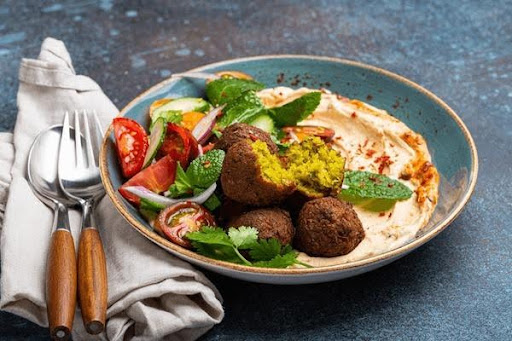Menu
Falafel: A Delicious Dive into the World’s Favorite Vegetarian Fritter

Falafel. The word itself conjures up images of vibrant green croquettes, nestled in fluffy pitas overflowing with fresh vegetables and creamy tahini sauce. But falafel is more than just a tasty treat; it’s a historical and cultural icon, a vegetarian champion, and a flavor explosion waiting to be savored.
This blog dives deep into the wonderful world of falafel, exploring its origins, delving into its variations, and offering tips for making and enjoying this delightful dish at home. So, whether you’re a seasoned falafel fanatic or a curious newcomer, buckle up for a delicious journey!
A History Steeped in Tradition
Falafel’s origins are as debated as they are delicious. Some believe it originated in ancient Egypt, developed by Coptic Christians as a protein source during religious fasts. Others point to its popularity in the Middle East and South Asia, suggesting a more widespread evolution. Regardless of its birthplace, falafel has become a staple food across the region, enjoyed by people from all walks of life.
Traditionally, falafel is made from dried chickpeas, soaked, ground, and mixed with fresh herbs like parsley and cilantro. Spices like cumin and coriander add warmth, and onions and garlic provide a savory base. The mixture is then formed into balls or patties and deep-fried until golden brown and crispy on the outside, with a soft and flavorful center.
A Culinary Canvas of Variations
Falafel’s beauty lies in its adaptability. While the core ingredients remain chickpea-based, regional variations offer different ingredients. Fava beans are sometimes used instead of chickpeas, particularly in Egypt. In Israel, falafel is often served with a side of chopped Israeli salad and amba, a tangy pickled mango condiment. Lebanon adds a twist with stuffed grape leaves and baba ghanoush, a smoky roasted eggplant dip.
Beyond the Middle East, falafel’s journey continues. In Europe, falafel wraps are a popular street food, often tucked into warm pitas with fresh vegetables and creamy sauces. In North America, falafel bowls are a trendy vegetarian option, featuring falafel alongside quinoa, roasted vegetables, and a variety of toppings.
The Vegetarian Hero: Falafel’s Nutritional Powerhouse Status
Falafel is a vegetarian’s dream come true. Packed with protein and fiber from chickpeas, it offers a satisfying and filling alternative to meat. It’s also a good source of iron, folate, and other essential nutrients. Additionally, falafel can be vegan-friendly by using oil instead of butter or eggs in the preparation.
Dieticians often recommend falafel as a healthy protein source, especially for those looking to reduce their red meat intake. When paired with healthy sides like whole-wheat pitas, fresh vegetables, and hummus, falafel forms a well-balanced and nutritious meal.
Mastering the Art of Falafel: Tips for Making Falafel at Home
Ready to embark on your own falafel-making adventure? Here are some tips to ensure success:
- Use dried chickpeas: While canned chickpeas are convenient, dried chickpeas soaked overnight offer a superior texture.
- Don’t over-grind the mixture: A slightly coarse texture allows for a better bite.
- Chill the falafel balls before frying: This helps them hold their shape and cook evenly.
- Don’t overcrowd the pan: This can lead to uneven frying and soggy falafel.
- Experiment with spices: Add a touch of cayenne pepper for a kick, or a pinch of cinnamon for a warmer flavor profile.
For those seeking a healthier alternative to deep-frying, falafel can be baked in the oven. Simply preheat your oven to 400°F (200°C) and bake the falafel balls for 20-25 minutes, flipping them halfway through.
Beyond the Pita: Creative Ways to Enjoy Falafel
Falafel’s versatility extends beyond the classic pita pocket. Here are some creative ways to incorporate falafel into your meals:
- Falafel salad: Combine crumbled falafel with chopped vegetables, leafy greens, and a light vinaigrette for a refreshing and protein-packed salad.
- Falafel burger: Use falafel patties as a base for a delicious and healthy vegetarian burger.
- Falafel wraps: Wrap falafel in lettuce leaves for a low-carb option or use collard greens for a heartier wrap.
- Falafel rice bowls: Combine falafel with brown rice, roasted vegetables, and a drizzle of tahini sauce for a satisfying and flavorful bowl.
The Final Falafel Farewell
Falafel is more than just a food; it’s a cultural experience, a symbol of vegetarian goodness, and a delicious journey for your taste buds. So, the next time you crave a satisfying and flavorful meal, consider giving falafel
a try. Whether you’re indulging in its traditional form nestled in a warm pita or exploring creative variations like falafel salads, burgers, wraps, or rice bowls, falafel never fails to delight. Embrace its rich history, savor its diverse flavors, and enjoy every crunchy, flavorful bite.
